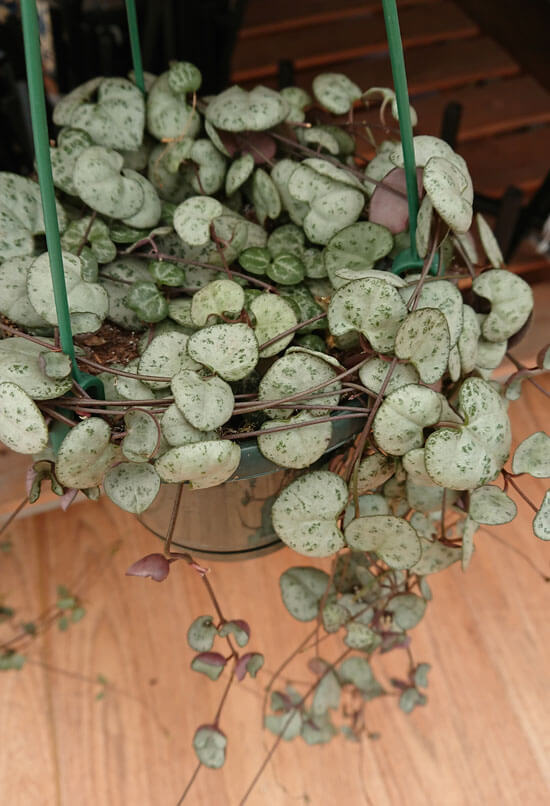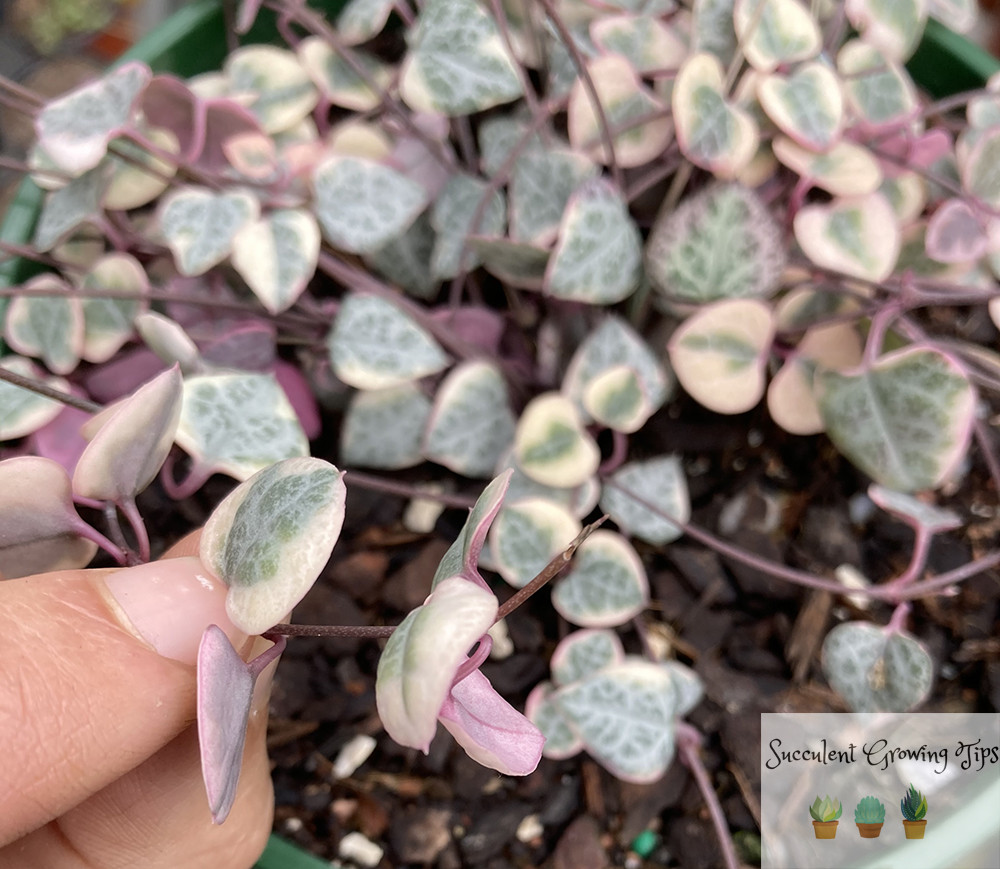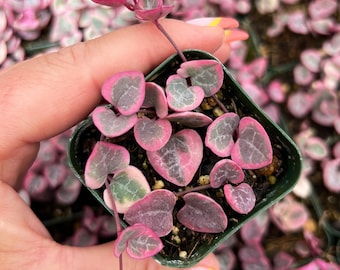
Overwatering and moist soil surrounding the roots are the main reasons of dying string of hearts plants, which causes the leaves to become yellow and the roots to rot. As a result of its sensitivity to the cold, string of hearts can wither away at consistently lower temperatures than 59°F (15°C).
The lower leaves of the string of hearts can fall off in response to low amounts of light, and they can also turn brown from sunburn.
Continue reading to learn the causes of the string of hearts plant’s (Ceropegia woodii) demise and the best methods for keeping the plant alive.
Table of Contents
String of Hearts Dying with Yellow Leaves (Over Watering)
- Symptoms. The delicate stalks and yellowing leaves of the string of hearts plant.
- Causes. Too much frequent watering, sluggish soil drainage, and pots with no drainage.
African natural string of hearts can be seen growing untamed in South Africa and Zimbabwe.
They are drought hardy and specially adapted to growing with little water around the roots since in their natural habitat, they grow in rocky or sandy soils and inhabit regions with infrequent rainfall and little humidity.
The string of hearts plant can have root rot, which can make stems and leaves black, and stress if the soil is persistently moist. Stress causes the leaves to turn yellow.
Most usually, excessively frequent watering, potting soil that retains moisture and is damp for an extended period of time without enough drainage, a pot without drainage holes at the bottom, or roots clogging the drainage hole are the causes of excessive moisture surrounding the roots.
Instead of constant wetness, String of Hearts does best when the soil is thoroughly saturated and then allowed to dry out between waterings.
Another typical error is placing a tray or saucer underneath the pot to prevent water from pouring inside.
The extra water in the pot cannot therefore be efficiently drained by the tray, and the potting soil remains damp, stressing your string of hearts with water.
It is crucial to mimic the arid circumstances of the plant’s natural habitat with occasional watering, special fast-draining soil, and planting it in a pot with drainage holes that allow water to escape in order to revive your fading string of hearts.
It is crucial to avoid fertilizing at this time because feeding a plant that may be dying is frequently bad for the plant’s health.
It should be noted that because string of hearts are dormant over the winter and are not actively developing, they are more prone to dying from overwatering during that time.
(Read my post on how to take care of a string of hearts for the finest care practices.)
How to Revive Dying String of Hearts due to Over Watering
- Restrict the irrigation. The most frequent reason for a dying string of hearts plant is overwatering. String of hearts can withstand drought, however they do not like their roots to be in wet potting soil. Give your string of hearts a good soak once a week in the spring and summer, and then every two to three weeks in the fall and winter when growth slows down to mimic their natural watering conditions. Humidity can also affect how frequently plants need to be watered; in humid locations, plants need watering less frequently.
- Change the dirt. String of hearts need potting soil that drains exceptionally well. The leaves become yellow when using regular potting mixtures because they retain too much moisture. Use a specific succulent and cactus potting mix for string of hearts that has the right drainage properties for a plant that can withstand drought (available from garden centers and on amazon). This improves drainage and enables the soil and roots to dry out in between watering sessions.
- A pot with drainage holes at the base is necessary for the string of hearts plant. Water collects around the roots in the absence of drainage pores, leading to root rot. Check to check if the drainage hole has been obstructed in any way, such as by soil compaction or pot-bound roots. If so, re-pot the heart-shaped thread in a slightly larger container. String of hearts can stay in the same pot for a very long time as long as it is well draining because it tolerates being pot bound well and does not require much fertilizer.
- Under the pot are trays, saucers, and decorative pots. A potted plant’s saucers keep water from dripping inside your house but also keep extra water from dripping out of the pot, keeping the soil soggy. Make sure the pot is not sitting in a pool of water by regularly emptying your saucers after using the water. Be sure to regularly check for excess moisture to avoid the string of hearts turning yellow and dying because decorative outer pots can also collect moisture.
Once you’ve taken these actions, the string of hearts will be able to recuperate from its water stress.
However, string of hearts should be propagated from cuttings if the leaves are getting increasingly yellow or even black despite efforts to revive the plant.
String of hearts plants are incredibly simple to grow, and you may effectively grow many more plants for no additional expense by taking cuttings from healthy plant tissue of an otherwise unhealthy plant.
See this useful YouTube video to learn how to propagate string of hearts plants:
String of Hearts with Brown Leaves
- Symptoms. While other leaves appear healthy and green, some leaves may have turned brown and burned.
- Causes. a sunburn Changing the location of the String of Hearts plant from a shaded area to a sunny one.
Although string of hearts is a native of hot, arid areas, its delicate leaves make it unsuitable for full sun.
The optimal conditions for growing string of hearts are strong indirect light or morning sun followed by afternoon shade.
The majority of issues arise from moving the string of hearts from one shaded area to another that receives direct sunlight.
String of hearts needs more time to adapt to a bright environment and does not perform well with a sharp increase in the amount of sun exposure or a sharp decrease in the intensity of the sun.
String of hearts plants with brown, sun-burned leaves can be easily distinguished from other stress-related issues because the leaves that are exposed to the most sunlight are the ones that are affected, whereas leaves that are more shaded and on the opposite side of the pot may continue to be relatively green and healthy.
Sun-burned leaves change color and appear scorched. Unfortunately, when a leaf is burned, it cannot be restored from its brown color. However, if the sunburn is somewhat limited rather than affecting the entire plant, the rest of the plant may be fine and continue to grow.
How to Revive Brown String of Hearts Plants

Trimming back stems with damaged leaves should encourage further development and help the plant recover over the coming weeks.
Move the string of hearts a little at a time if you’re transferring it to a more sunny spot.
To give the leaves a chance to adjust to more direct sun without dealing with a stark difference and burning their leaves, move the pot progressively to the sunnier location over the course of three weeks for a half-hour longer every three days.
Take into account that if you relocated your string of hearts plant to an area with more sunlight, the additional sun can raise temperatures, which can increase the need for water.
To keep the string of hearts healthy and to lessen any transplant shock, water assiduously once a week (provided you have well-draining soil).
If the leaves of a dry string of hearts plant are curled or shriveled and appear a little bit brown, you should water it more frequently until it adjusts.
(Read my article about curling heart-shaped leaves.)
I advise trying to propagate any of the healthier appearing stems to restore badly sun-damaged string of hearts plants with a lot of scorched leaves.
String of Hearts Leaves Brown and Shriveled
- Symptoms. Brown leaves curled or shriveled after turning brown.
- Underwatering, overwatering, excessive heat, and improper soil mix are the causes.
Even though string of hearts is renowned for its ability to withstand drought, there are times when it lacks moisture.
When a string of hearts plant is dehydrated, the leaves should curl and appear shrunken as well as turn brown; in contrast, sunburned plants usually turn brown but their leaves do not curl or shrink to the same amount.
In contrast to sunburn, which only affects leaves that have received the most sun exposure, string of hearts under drought stress also affects all of the leaves.
A thorough soak is necessary for string of hearts, typically once a week or so, to ensure that water drains from the pot’s bottom.
Drought stress may result from less regular or light-handed watering.
If you water your plants too little, the moisture may only reach the top inch or two of the soil and not the roots, where it is needed.
Potting soil is an additional crucial component.
The soil can bake hard when it dries out entirely if the string of hearts is put in regular potting soil as opposed to succulent and cactus soil.
It is possible for completely dry soil to be hydrophobic, which prevents water from penetrating the soil surface and reaching the roots.
As a result, even if you may give your plant a nice soak and water may drip from the base, the drought stress is still present because the water has not permeated the soil and reached the roots.
The rate at which the plant dries out and experiences drought can be accelerated by excessive heat from radiators, dry air currents from forced air or air conditioning, or both.
(Read my article on how to water a string of hearts for the best watering techniques.)
How to Revive String of Hearts Leaves that are Brown and Shriveled
- In the Spring and Summer, increase the watering to roughly once weekly, and in the Winter, to once every three to four weeks. String of hearts typically thrive with this balance of watering because it gives the plant just the right amount of moisture while allowing the soil to be just barely dry enough to prevent any effects from overwatering. This mimics the moisture conditions of the plant’s native habitat, which has infrequent rainfall and good drainage.
- Modify the potting soil. When normal potting mixtures entirely dry up, they can start to become water-repellent, forcing water to flow off the surface and out the bottom of the pot without getting to the roots. Repot your string of hearts in a succulent and cactus potting mix, which replicates the soil qualities of its natural environment and is porous enough to allow water to penetrate the soil and reach the roots even after it has totally dried up.
- Give the plant a good soak rather than just a light misting when watering your string of hearts. Don’t take the directions for watering to mean that not much water is needed. It is necessary to soak string of hearts thoroughly so that water drips from the pot’s bottom. Light irrigation does not reach the roots, causing the plant to experience drought stress. As long as your soil has good drainage, string of hearts just has to be watered once every week as opposed to more frequently for most plants.
- Overheating can hasten the drying out of your potted string of hearts and increase water loss from the leaves, which could lead to drought stress in the summer. If so, relocate it to a more shaded area and give it a thorough soak once a week.
Cold Temperatures Can Causes a Dying String of Hearts Plant
South Africa and Zimbabwe have hot, arid conditions where the string of hearts is endemic.
They often adapt well to indoor temperatures but are not frost hardy and are sensitive to extreme cold.
Growth that appears limp, twisted, or darkened could indicate harm from the ice.
String of hearts can suffer from colder temperatures and does best in environments that are 59°F (15°C) or warmer.
Keep your string of hearts in cozy, well-lit areas, and the plant should recover.
Too Much Shade Causes Leaves to Turn Light Green, Fall off and Slow Growth

The plant thrives in these conditions and maintains the healthiest growth. The variety may vary, but the leaves are often variegated with a spectrum of whites and some subdued reds.
The plant is in too much shade if its leaves are turning light green and it is growing slowly.
String of hearts that are deprived of light have a tendency to become lanky, with scant leaves on the bottom stems and some leaves falling off.
The overall health of the plant suffers from insufficient light, and if it is left in too much shade, it may even perish.
Place the pot in an area with bright indirect light to revitalize it. Avoid moving it in the sun since the change from shade to sun can cause it to burn.
String of hearts can burn in direct sunlight because they are sensitive to changes in light.
Your string of hearts ought to come to life with the correct amount of light.
If the plant appears scant, cut back any extra growth; the plant will eventually recover.
Key Takeaways:
- Overwatering or poorly draining soils can cause too much moisture to build up around the roots of a string of hearts plant, leading to yellow leaves and root rot.
- Sunburn causes the string of hearts plant’s leaves to turn brown, and too much shade can cause the leaves to fall off.
- Due to inadequate moisture and excessive temperatures, the leaves of the string of hearts become brown and withered. Cold temperatures can cause a string of hearts to stop beating.
- In order to keep string of hearts alive, water them once a week and plant them in potting soil made specifically for succulent and cactus. To save the plant if there is considerable solar damage or leaf yellowing, propagate any healthy growth.
